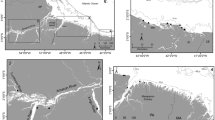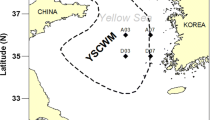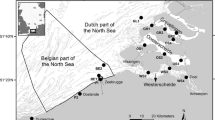Abstract
Stable isotopes are increasingly used to investigate seasonal migrations of aquatic organisms. This study employed stable isotopes (δ 13C and δ 15N) for Coilia nasus from the lower Yangtze River and the adjacent East China Sea to distinguish different ecotypic groups, ascertain trophic nutrition positions, and reflect environmental influences on C. nasus. δ 13C signatures of C. nasus sampled from Zhoushan (ZS), Chongming (CM), and Jingjiang (JJ) waters were significantly higher than those from the Poyang Lake (PYL) (P < 0.05). By contrast, δ 15N signatures of C. nasus in ZS, CM, and JJ groups were significantly lower than those in PYL group (P < 0.05). Basing on δ 13C and δ 15N signatures, we could distinguish anadromous (ZS, CM, and JJ) and non-anadromous (PYL) groups. The trophic level (TL) of anadromous C. nasus ranged from 2.90 to 3.04, whereas that of non-anadromous C. nasus was 4.38. C. nasus occupied the middle and top nutrition positions in the marine and Poyang Lake food webs, respectively. C. nasus in Poyang Lake were significantly more enriched in δ 15N but depleted in δ 13C, suggesting that anthropogenic nutrient inputs and terrigenous organic carbon are important to the Poyang Lake food web. This study is the first to apply δ 15N and δ 13C to population assignment studies of C. nasus in the Yangtze River and its affiliated waters. Analysis of stable isotopes (δ 15N and δ 13C) is shown to be a useful tool for discriminating anadromous and non-anadromous C. nasus.
Similar content being viewed by others
References
Bannon, R. O., and Roman, C. T., 2008. Using stable isotopes to monitor anthropogenic nitrogen inputs to estuaries. Ecological Applications, 18 (1): 22–30.
Bardonneta, A., and Riera, P., 2005. Feeding of glass eels (Anguilla anguilla) in the course of their estuarine migration: New insights from stable isotope analysis. Coastal and Shelf Science, 63 (1): 201–209.
Best, P. B., and Schell, D. M., 1996. Stable isotopes in southern right whale (Eubalaena australis) baleen as indicators of seasonal movements, feeding and growth. Marine Biology, 124 (4): 483–494.
Cabana, G., and Rasmussen, J. B., 1994. Modeling food chain structure and contaminant bioaccumulation using stable nitrogen isotopes. Nature, 372 (6503): 255–257.
Cai, D. L., Li, H. Y, Tang, Q. S., and Sun, Y., 2005. Establishing trophic chart of ecosystem in the Yellow Sea and East Sea based on the stable isotope results. Scientia Sinica Vitae, 35 (2): 123–130.
Carmichael, R. H., Rutecki, D., Annett, B., Gaines, E., and Valiela I., 2004. Position of horseshoe crabs in estuarine food webs: N and C stable isotopic study of foraging ranges and diet composition. Journal of Experimental Marine Biology and Ecology, 299 (2): 231–253.
Castro, P., Valiela, I., and Freitas, H., 2007. Eutrophication in Portuguese estuaries evidenced by δ 15N of macrophytes. Marine Ecology Progress Series, 351: 43–51.
Cheng, Q. Q., Lu, D. R., and Ma, L., 2005. Morphological differences between close populations discernible by multivariate analysis: A case study of genus Coilia (Teleostei: Clupeiforms). Aquatic Living Resources, 18 (2): 187–192.
Cheng, W. X., and Tang, W. Q., 2011. Some phenotypic varieties between different ecotypes of Coilia nasus in the Yangtze River. Chinese Journal of Zoology, 46 (5): 33–40.
Fertig, B., O’Neil, J. M., Beckert, K. A., Cain, C. J., Needham, D. M., Carruthers, T. J. B., and Dennison, W. C., 2013. Elucidating terrestrial nutrient sources to a coastal lagoon, Chincoteague Bay, Maryland, USA. Estuarine, Coastal and Shelf Science, 116: 1–10.
Fuji, T., Kasai, A., Suzuki, K. W., Ueno, M., and Yamashita, Y., 2011. Migration ecology of juvenile temperate seabass Lateolabrax japonicus: A carbon stable isotope approach. Journal of Fish Biology, 78 (7): 2010–2025.
Grall, I., Le, Loc’h, F., Guyonnet, B., and Riera, P., 2006. Community structure and food web based on stable isotopes (δ 15N and δ 13C) analysis of a North Eastern Atlantic maerl bed. Experimental Marine Biology and Ecology, 338 (1): 1–15.
Gu, B., Schell, D. M., Frazer, T., Hoyer, M., and Chapman, F. A., 2001. Stable carbon isotope evidence for reduced feeding of Gulf of Mexico sturgeon during their prolonged river residence period. Coastal and Shelf Science, 53 (3): 275–280.
Jacob, U., Mintenbeck, K., Brey, T., Knust, R., and Beyer, K., 2005. Stable isotope food web studies: A case for standardized sample treatment. Marine Ecology Progress Series, 287: 251–253.
Karube, Z., Sakai, Y., Takeyama, T., Okuda, N., Kohzu, A., Yoshimizu, C., Nagata, T., and Tayasu, I., 2010. Carbon and nitrogen stable isotope ratios of macroinvertebrates in the littoral zone of Lake Biwa as indicators of anthropogenic activities in the watershed. Ecological Research, 25 (4): 847–855.
Kline, T. C., Wilson, W. J., and Goering, J. J., 1998. Natural isotope indicators of fish migration at Prudhoe Bay, Alaska. Canadian Journal of Fisheries and Aquatic Sciences, 55 (6): 1494–1502.
Lake, J. L., McKinney, R. A., Osterman, F. A, Pruell, R. J, Kiddon, J., Ryba, S. A., and Libby, A. D., 2001. Stable nitrogen isotopes as indicatiors of anthropogenic activities in small freshwater systems. Canadian Journal of Fisheries and Aquatic Sciences, 58 (5): 870–878.
Lebreton, B., Richard, P., Parlier, E. P., Guillou, G., and Blanchard, G. F., 2011. Trophic ecology of mullets during their spring migration in a European saltmarsh: A stable isotope study. Coastal and Shelf Science, 91 (4): 502–510.
Le Loc’h, F., and Hily, C., 2005. Stable carbon and nitrogen isotope analysis of Nephrops norvegicus/Merluccius merluccius fishing grounds in the Bay of Biscay (NE Atlantic). Canadian Journal of Fisheries and Aquatic Sciences, 62 (1): 123–132.
Luo, B. Z, Xue, P., Lu, J. W., and Huang, S. F., 1992. Impact of the Three Gorges Project on the fishery of the Changjiang estuary and adjacent waters. Studia Marina Sinica/Haiyang Kexue Jikan, 33: 341–351.
McClelland, J. W., Valiela, I., and Michener, R. H., 1997. Nitrogen- stable isotope signatures in estuarine food webs: A record of increasing urbanization in coastal watersheds. Limnology and Oceanography, 42 (5): 930–937.
Minagawa, M., and Wada, E., 1984. Stepwise enrichment of 15N along food chains: further evidence and the relation between δ 15N and animal age. Geochimica et Cosmochimica Acta, 48 (5): 1135–1140.
Nixon, S. W., Buckley, B. A., Granger, S., L., Entsua-Mensah, M., Ansa-Asare, O., White, M. J., Mckinney, R. A., and Mensah, E., 2007. Anthropogenic enrichment and nutrients in some tropical lagoons of Ghana, West Africa. Ecological Applications, 17 (sp5): S144–S164.
Peterson, B. J., and Fry, B., 1987. Stable isotopes in ecosystem studies. Annual Review of Ecology and Systematics, 18: 291–320.
Post, D. M., 2002. Using stable isotopes to estimate trophic position: Models, methods, and assumptions. Ecology, 83 (3): 703–718.
Sackett, W. M., and Thompson, R. R., 1963. Isotopic organic carbon composition of recent continental derived clastic sediments of eastern Gulf Coast, Gulf of Mexico. Bulletin of the American Association of Petroleum Geologists, 47 (3): 525–531.
Vander Zanden, M. J., and Rasmussen, J. B., 2001. Variation in δ 15N and δ 13C trophic fractionation: implications for aquatic food web studies. Limnology and Oceanography, 46 (8): 2061–2066.
Vizzini, S., and Mazzola, A., 2006. The effects of anthropogenic organic matter inputs on stable carbon and nitrogen isotopes in organisms from different trophic levels in a southern Mediterranean coastal area. Science of the Total Environment, 368 (2): 723–731.
Walker, J. L., Potter, C. W., and Macko, S. A., 1999. The diets of modern and historic bottlenose dolphin populations reflected through stable isotopes. Marine Mammal Science, 15 (2): 335–350.
Wang, D. T., Yang, J., Jiang, T., Liu, H. B., and Shen, X. Q., 2012. A comparative study of the morphology of different geographical populations of Coilia nasus. Journal of Fisheries of China, 36 (1): 79–90.
Wang, Y. Y., Yu, X. B., Zhang, L., and Xu, J., 2009. Food web structure of Poyang Lake during the dry season by stable carbon and nitrogen isotopes analysis. Acta Ecologica Sinica, 29 (3): 1181–1188.
Whitehead, P., Nelson, G., and Wongratana, T., 1988. FAO species catalogue. Clupeoid fishes of the world (Suborder Clupeoidei). Part 2. Engraulididae. FAO Fisheries Synopsis, 125 (7): 460–475.
Xu, J., Xie, P., Zhang, M., and Yang, H., 2005. Variation in stable isotope signatures of seston and a zooplanktivorous fish in a eutrophic Chinese lake. Hydrobiologia, 541 (1): 215–220.
Xu, Z. Q., Ge, J. C., Huang, C., Dou, H. X., Pan, J. L., and Xia, A. J., 2009. Taxonomy of short jaw tapertail anchovy Coilia brachygnathus by jaw length and mitochondrial Cytochrome b gene analysis. Journal of Dalian Fisheries University, 24 (3): 243–246.
Yang, J., Arai T., Liu, H., Miyazaki, N., and Tsukamoto, K., 2006. Reconstructing habitat use of Coilia mystus and Coilia ectenes of the Yangtze River estuary, and of Coilia ectenes of Taihu Lake, based on otolith strontium and calcium. Journal of Fish Biology, 69 (4): 1120–1135.
Yuan, C. M., Qin A. L., Liu, R. H., and Lin J. B., 1980. On the classification of the anchovies, Coilia from the lower Yangtze River and the southeast coast of China. Journal of Nanjing University, 3: 67–82.
Yuan, C. M., 1987. Spawning migration of Chinese anchovy Coilia ectenes. Bulletin of Biology, 12: 1–3.
Zhang, M. Y., Xu, D. P., Liu, K., and Shi, W. G., 2005. Studies on biological characteristics and change of resource of Coilia nasus Schlegel in the lower reaches of the Yangtze River. Resources and Environment in the Yangtze Valley, 14 (6): 694–698.
Zhuang, P., Luo, G., Zhang, T., Zhang, L. Z., Liu, J. Y., Feng, G. P., and Hou, J. L., 2010. Food comparison among juvenile Acipenser sinensis and other six economic fishes in the Yangtze estuary. Acta Ecologica Sinica, 30 (20): 5544–5554.
Author information
Authors and Affiliations
Corresponding author
Rights and permissions
About this article
Cite this article
Wang, L., Tang, W. & Dong, W. The signatures of stable isotopes δ 15N and δ 13C in anadromous and non-anadromous Coilia nasus living in the Yangtze River, and the adjacent sea waters. J. Ocean Univ. China 14, 1053–1058 (2015). https://doi.org/10.1007/s11802-015-2611-3
Received:
Revised:
Accepted:
Published:
Issue Date:
DOI: https://doi.org/10.1007/s11802-015-2611-3




